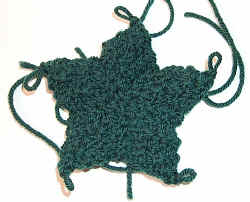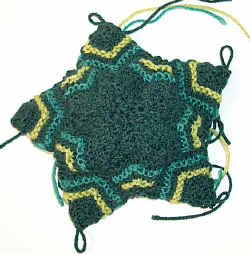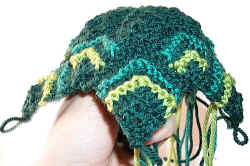

Okay, I promised myself I'd get back to dealing with Ted's Hat this week -- I spent some time squinting at my photocopy, I made some notes and drawings of modules, and I even knitted one. It wasn't right....then I spent sometime measuring my head and wondering if I'd ever figure it all out. Here's what I knew:
| Ted had used two strands of Jamieson and Smith Shetland 2-ply jumper weight for the modules. This ends up being about worsted weight. | |
| Ted had created several different sizes of modules in order to create a "hat shape", with larger modules at the bottom, gradually decreasing to smaller modules at the top. |
Then I received an e-mail from Ted, with some scans, and some notes. Here's part of what he wrote:
"Working the hat from-the-top-down with the size of the squares increasing to shape the hat is what I was interested in exploring."
According to Ted, the top-down approach should allow the knitter to make this hat to fit any sized head. One of the things Ted and I have talked about in the past was the strange phenomenon I found with my own knitting -- I've worked on two vests with the modules set as diamonds, and based the width of the garment on my sample module. However, the final circumference of the vest was not what I'd expected. With a diamond of a width of 10 cm, I would have expected a row of 10 to measure 1 metre.....but this wasn't happening. I'm still not sure why, but Ted and I explored a lot of possibilities.
However, based on that conundrum, Ted wrote, "I'm not convinced that the size of the hat has to be determined by the width of the diamonds. It doesn't necessarily follow that if you have 5 diamonds each measuring 4", then the hat will be 20" in circumference."
Ted went on to write:
"There's no rule, as far as I can see, that all diamonds in a row have to have the same number of stitches." (NOTE TO SELF: This, therefore, means, that you can play with the size of a particular row of modules -- out of five, two might have a slightly different stitch count, which will have an effect on the circumference at that point in the hat).
"They have to be the same number of rows, or things start getting really strange." (NOTE TO SELF: This would mean that some of the modules on a particular row would be LONGER than others, which would make it an interesting challenge to work the next row of modules.)
"But if you have a module based on 26 sts in a row of modules based on 28 sts , it means that for the 26 st module you need to omit a decrease row to have the same number of rows as the 28 st module." (NOTE TO SELF: I didn't understand this the first time I read it, but now that I've worked three sets of modules on my hat, it's very clear.
To summarize: To work this version of the hat, modules in the same level must always have the same number of rows. If you want to make them a different number of stitches to add a smidge of width at that point, then you will have to work an extra decrease OR leave out an extra increase row....did I mention that there are increases in the form of M1 snuck into the sides of the modules in order to make the modules on each row progressively larger???)
Finally Ted noted: "This *should* allow you to customize hat circumferences, since a 26 st module may well be narrower than a 28 row module. Not much, mind you, but if you had a couple of them in a row of 28 st modules, then the hat's circumference will be less. Right?" (NOTE TO SELF: Er, yes, in theory. And the inverse would also be true -- if you threw in a couple of modules based on 28 sts in a row of modules based on 26 sts, then the circumference would be fractionally larger....)
Shall I tempt you with a couple of photos of the Work In Progress?
| Description |
Picture |
| Twinkle, twinkle, little star... Five small garter welt diamond modules form the crown of the hat. |
 |
| The modules get progressively larger as you work the levels down the hat. |
 |
| Side view of the hat... looking a little squashed here. |
 |
| Here it is with a little shape, courtesy of my hand. Notice that there are a lot of ends that need to be worked in. I remember that Ted had a concern about the extra bulk, so I'm going to work them in at the end, splitting the strands of yarn, in order to try to minimize this problem. |
 |
So as you can see, I've got three levels of modules finished, and I've now started work on the fourth. Next Up: I'll write the pattern I've been drafting based on Ted's notes -- but I can already see that I have to make some changes based on another e-mail he sent me......
![]()
Modknit | What's New | Resources/Links | Lessons | Patterns | Process to Product
![]()
Text and Images Copyright 2000-2004 Katherine Matthews (except where otherwise noted)
This page last modified 07 May 2017